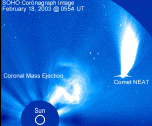

The Nucleus (70 km diameter) of Comet Hale-Bopp has a Satellite (30 km diameter) with orbital radius between 160 and 210 km and orbital period (at 180 km orbital radius) of about 2-3 days. Pic du Midi Observatory images indicate the nucleus rotates with a period of 11.47 +/- 0.05 hours.
Hale-Bopp was discovered in July 1995, about 2 months after May 1995 when Annals of Math published a Proof of Fermat's Last Theorem.
Hale-Bopp's past period is about 4200 years, and its future period about 2400 years.
If Sitchin's Sumerian Solar System body Nibiru, with period (as known to the Sumerians) of roughly 3600 years, were a Comet, then maybe it could have been Comet Hale-Bopp (a conjecture that came from e-mail discussion with Ron Nye). Since the last period of Comet Hale-Bopp was about 4200 years, if its preceding two periods were each about 3600 years, then Hale-Bopp would have had a perihelion about 11,400 years ago, which is, at the level of uncertainty in these matters, the same as 11,600 years ago. Therefore, it is possible that Comet Hale-Bopp could have been affected by supernova Vela X.
About 4200 years ago (about Chinese year 500) Comet Hale-Bopp last appeared at Earth, and Yu (father of the first emperor of the Xia dynasty) saw, rising from the Lo River, a turtle with markings of the Lo Shu.
Around the same time, according to Russell Sipe, about 2214 BC, in southern Mesopotamia,a victory Stela for Akkadian king Naram-Sin showed two suns,such as might represent the Sun and a spectacular daylight-visible Hale-Bopp.
Also around the same time, according to a 4 November 2001 article by Robert Matthews in the London Telegraph by Robert Matthews, in the London Telegraph: "... a devastating meteor impact in the Middle East might have triggered the mysterious collapse of civilisations more than 4,000 years ago.

Studies of satellite images of southern Iraq have revealed a two-mile-wide circular depression which scientists say bears all the hallmarks of an impact crater. If confirmed, it would point to the Middle East being struck by a meteor with the violence equivalent to hundreds of nuclear bombs. Today's crater lies on what would have been shallow sea 4,000 years ago, and any impact would have caused devastating fires and flooding. The catastrophic effect of these could explain the mystery of why so many early cultures went into sudden decline around 2300 BC. They include
The crater also appears to be, in geological terms, very recent. Dr Master said: "The sediments in this region are very young, so whatever caused the crater-like structure, it must have happened within the past 6,000 years." ... "If we could find fragments of impact glass, we could date them using radioactive dating techniques," he said. ... Dr Benny Peiser ... said that craters recently found in Argentina date from around the same period - suggesting that the Earth may have been hit by a shower of large meteors at about the same time. ...".
In 1997 (Chinese year 4694) Comet Hale-Bopp returned, Deng Xiaoping died, and Hong Kong returned to China, the 1997 El Nino seemed to be the strongest yet, a large Earthquake, between 7.9 and 7.5, hit China about 700 km northwest of Lhasa, Tibet (The 1976 Tangshan Earthquake was 7.8.), and construction began on the Three Gorges Dam on the Yangtze River. Volcanoes Soufriere on Montserrat and Popocatepetl erupted, and Mt. Etna showed activity. In 1998, but before the Chinese New Year, a 6.2 Earthquake hit China near Beijing.
Around 24 February 1996, Hale-Bopp crossed the Ecliptic Plane near Jupiter's orbit where Jupiter had been about July 1984.
Around 5 May 1997, Hale-Bopp crossed the Ecliptic Plane near Earth's orbit where Earth would be about January 1998.
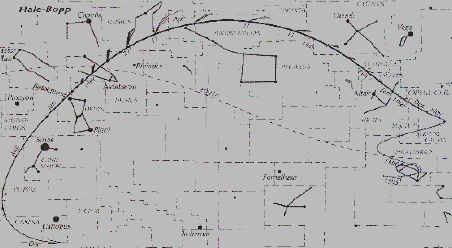
After discovery in July 1995 near the Galactic Center in Sagittarius, Hale-Bopp moved Northerly to the East (Altair) side of the Milky Way.
Around 24 February 1996, Hale-Bopp crossed the Ecliptic Plane at Jupiter's orbit about 0.75 AU (about 110 million km) from Jupiter.
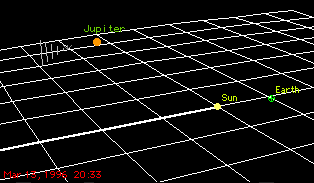
About 3 June 1996 Jupiter crossed the orbit of Hale-Bopp, perhaps encountering a meteor shower in the cometary orbit.
On 3 June 1996 Hale-Bopp was about 1.3 AU from Jupiter.
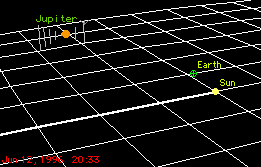
Hale-Bopp disappeared from view Dec 96 to Feb 97 due to sunlight, then moved westerly across the Milky Way so that by September 1996 it was in the evening sky in Ophiuchus on the West (Vega) side of the Milky Way.
From Sep 96 to Feb 97 it moved across the Milky Way toward Altair.
In December 1996, the Sun was be there too, perhaps symbolically carrying Hale-Bopp across the River of the Milky Way from the side of the Weaving Woman (Vega, Chih Nu, Chik-nyo) to the side of the Cowboy (Altair, Chien Niu, Kyon-u).
In January 1997 Hale-Bopp reappeared in the morning sky, and went from Aquila toward Cygnus.
During March 1997 Hale-Bopp's Hydrogen Cloud cast its ultraviolet shadow
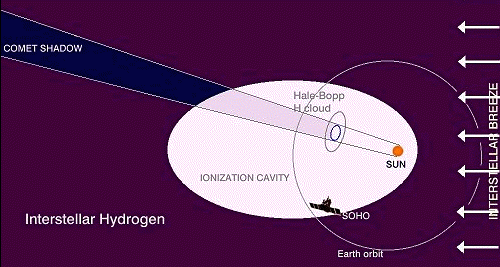
(SOHO SWAN images dated 25 Feb 97, 01 Mar 97, and 08 Mar 92)

as it appeared from Earth to approach the Andromeda Galaxy M31.
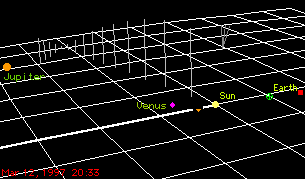
At perihelion on 1 April 1997 Hale-Bopp was about 0.9 AU above the Sun and somewhat more than 1.3 AU from Earth.
In late April 1997 Hale-Bopp passed near the Pleiades.
Around 5 May 1997, while in Taurus, Hale-Bopp crossed the Ecliptic Plane about 1.1 AU from the Sun,
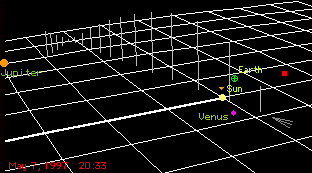
only about 15 million km beyond Earth's orbit.
In early June; late July; and late October 1997; Hale-Bopp passed near Betelgeuse and the Galactic AntiCenter; Sirius; and Vela X; respectively.
In early January 1998, this was roughly the planetary configuration:
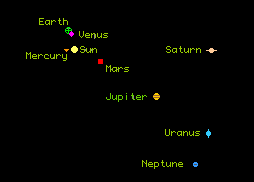
(for long-period Saturn, Uranus, and Neptune, the configuration was roughly the same from 1995 to January 1998).
According to ESO press release 16/98 dated 22 October 1998: "... ESO ... PR Photo 40c/98 shows Comet Hale-Bopp, as imaged on October 19, 1998 ...
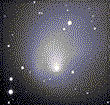
... Just over 18 months after its perihelion passage on April 1, 1997, Comet Hale-Bopp ... is continuing its outward journey through the Solar System. It is [22 October 1998] about 1,000 million kilometres ( 6.7 AU [which is beyond the orbit of Jupiter at 5.20 AU] ) from the Sun and the Earth, i.e. almost at the same distance as when it was first discovered in July 1995 ... and is now seen in the southern constellation Volans (The Flying Fish), i.e. just east of the Large Magellanic Cloud ... [and is] ... visible in binoculars to southern observers as a fuzzy object with a diameter of a few arcminutes. ... [ESO] radio observations ... observed emission from methanol (CH3OH) and hydrogen cyanide (HCN) molecules, never before detected in any comet this far away. ... observations of CH3OH in August 1998 show that the coma is now very cold at about 16 K (-257 degrees C). At perihelion (0.9 AU from the Sun), the corresponding temperature was of the order of 110 K (-163 degrees C). The expansion velocity has also considerably decreased since perihelion, from 1.1 km/sec to 0.5 km/sec. There is also evidence of anisotropic outgassing: more gas is seen to be flowing out from the sunlit hemisphere of the nucleus. ... a very complex coma structure is still present. Due to the large size of the nucleus, probably 40 - 60 km in diameter, it will be possible to observe this comet with large optical telescopes for many years to come. ... The monitoring of Comet Hale-Bopp at the SEST telescope will continue, at least until March 1999. The comet will then be nearly 1,200 million km (7.9 AU) from the Sun [not as far as the orbit of Saturn at 9.54 AU] ...".
Perhaps material from Hale-Bopp might then enter a newly-discovered type of stable Earth orbit with 40 million km semimajor axis and 20 million km semiminor axis.
The American Meteor Society Bright Meteor Diary included multiple reports from Colorado Springs, CO, of a fireball occuring at 0010 MST on 11 January 1998. The directions in the multiple reports were listed as SW-NE.
Shortly after midnight on 11 January 1998, according to the Rocky Mountain News of 17 January 1998, thousands of Front Range residents saw a meteor fireball that may have been a stray chunk of Comet Hale-Bopp. Judging by its flight path over Monument, geologists at the Denver Museum of Natural History and private collectors raced to southwest Elbert County to search for fragments of the meteorite. University of Denver astronomer Robert Stencel said that it is uncertain whether the meteorite originated with Hale-Bopp, but that all the distances, angles, velocities and known orbits of the key celestial factors raise the odds considerably, and that only study of the fragments can resolve the matter.
Graeme Waddington of the MRC Magnetic Resonance Spectroscopy Unit, John Radcliffe Hospital, Oxford, said on 21 January 1998: "Further to my note of yesterday I have now been able to check the details and find that the mooted Hale-Boppid radiant would have actually been just BELOW the north-eastern horizon as seen from Denver at the quoted time of observation: The radiant would not have risen above the Denver horizon until 25 minutes later. The Colorado bolide therefore had no connection with comet Hale-Bopp."
I disagree with the conclusion of Graeme Waddington, because if the radiant were just below the horizon then the meteor would have approached the Earth's atmosphere almost tangentially so that the path of the meteor could have been altered by its encounter with the Earth's atmosphere, as, for example by "skipping" like a stone skipped on water.
According to USA TODAY (02/15/98- DENVER) - "The phone lines to Denver's Museum of Natural History have been buzzing since a fireball streaked across the Colorado sky [in January 1998]. That flash of light, caught on a homeowner's security camera, was not an isolated incident; it was followed by at least four more fireball sightings, said Jack Murphy of the museum's geology department. He hopes to find pieces of the celestial objects for the museum's collection. As new reports of sightings keep coming in, scientists are debating the meteorites' origin and the meaning of the increased activity. ... When a fireball fell into the Earth's atmosphere on Jan. 11, a Front Range resident's home security camera documented the bright light and shadows along with the sonic boom caused by the apparent meteorite, [Doug Revelle, a scientist at Los Alamos National Laboratory] said. Scientists will use the time between the flash and boom - 132 seconds - to help determine where the meteorite touched down, assuming it didn't burn out before landing. Then, at about noon on Jan. 27, a commercial airline pilot flying over Wyoming spotted "a ball of flame trailing smoke." "He reported he did get some turbulence from the object," Jim Patton, operations supervisor for the Federal Aviation Administration's flight service center in Casper told the Rawlins, Wyo., Daily Times. "He saw the debris and felt the shock wave from it." Residents in Breckenridge, Colo., also reported seeing that daytime fireball. Murphy said they believe the space rock was heading south to north and landed just north of Hanna, Wyo. That night, another fireball broke into the Earth's atmosphere. Scientists believe that meteorite came down in southern Colorado or northern New Mexico, Murphy said. People in Breckenridge spotted that fireball, too. "That one was seen traveling east to west," Murphy said. "It has been a long time since we've seen one moving like that." Another meteorite was seen and heard at sunrise in eastern Colorado on Jan. 30. And Murphy is investigating a report that came in earlier this month. So what's happening? "I don't know," Murphy said. "We can't attribute it to anything. But it is unusual to have so much activity." University of Denver astronomer Robert Stencel suggested that Earth may be getting pelted with pieces of the Hale-Bopp comet. Early in January the Earth passed through the part of space the comet had traveled. "Comets are like kids with muddy boots," Stencel said. "They leave a trail of debris in their wakes." ... The reports describe a smoke trail following the fireballs - or bolides, which are exploding meteors. "The smoke trail is an indication that the object was quite big and strong," Revelle said. "Over the globe we see objects that are about a meter across an average of only 12 times a year." Last Oct. 10, a meteorite crashed near West Texas and New Mexico; then on Dec. 9, a large fireball crashed near Greenland, and on Dec. 13, a meteorite was seen across hundreds of miles, from Minnesota and Wisconsin south into Iowa and northern Missouri."..."
According to Sky and Telescope Weekly News Bulletin of 27 March 1998: "On Sunday, March 22nd, just before 7 p.m. local time, a fireball was seen blazing and then exploding over Texas. Shortly thereafter, a hunk of rock hit the ground in the city of Monahans, located 340 km (210 miles) east of El Paso. The fragment, first found by youths who were playing basketball about 10 meters away, measured 22-by-10-by-5 centimeters (9-by-4-by-2 inches). A second, smaller fragment was found the next day about 240 meters (800 feet) away from the first. The meteorites have been classified as chondrites, or stony meteorites. More pieces are likely in the area."
In January 1999, Earth was again near the orbit of Comet Hale-Bopp. According to an article in the Anchorage Daily News of Sunday, January 10, 1999, by Elizabeth Manning, "... A brilliant flash and earthshaking boom noticed by thousands of Alaskans late Friday were likely a meteor exploding in Earth's atmosphere ... Donald Martins, an astronomy professor at the University of Alaska Anchorage, wasn't lucky enough to see the object that streaked blue, green and red across the Southcentral Alaska sky. But based on witness accounts, Martins and other scientists believe the flash came from a meteor or comet fragment - probably the size of a pumpkin - that exploded about 50 miles above Earth's surface. ... Dozens of people phoned authorities late Friday to report the event, which happened about 10:25 p.m. Most eyewitnesses described a brilliant and colorful flash, followed several minutes later by a boom. The boom was so loud it shook houses in Palmer and Wasilla and was heard from South Anchorage to Sutton and beyond. ... Greg Durocher, a scientist with the U.S. Geological Survey ... and other observers of the fireball said they heard the boom about three or four minutes after they saw the flash ... There were rumors Friday of objects striking the Parks Highway at Mile 141 and reports by pilots of debris falling ...". I wonder whether the meteorite could have been a fragment of Comet Hale-Bopp.
According to Sky and Telescope News for 22 January 1999: "In the early morning of January 14th, many residents of Hawaii were awoken by the flash and sound of a bright fireball that exploded over the island chain.
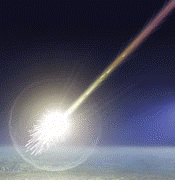
Sky & Telescope contributing editor Stephen James O'Meara witnessed the bolide as he was preparing to do some observing. The explosion -- which he estimates reached magnitude -20 -- came at approximately 3:47 a.m. He witnessed many fragments of the shattered meteoroid followed by smoky trails. "The flash it produced was blinding," O'Meara says, "as if I someone had just ignited a welder's torch at night. About 10 seconds later, a loud explosion caused me to flinch. The noise was not like that of a volcanic explosion or of thunder, but more like that of a depth charge detonating beneath the sea. That initial explosion was followed by 30 seconds (I counted) of rumbling, like rolling thunder."". I wonder whether the meteorite could have been a fragment of Comet Hale-Bopp.
In January 2000, Earth was yet again near the orbit of Comet Hale-Bopp. According to a 25 January 2000 article in Space Science News: "... one of the most dramatic meteors in 10 years streaked across the skies of the Yukon Territory in Canada. Witnesses reported two sonic booms, a foul odor, and sizzling sounds heard all the way from Alaska through northwestern Canada. Based on readings from defense satellites and seismic monitoring stations, scientists estimate that the meteor detonated with the energy of two to three kilotons of TNT. ... Joe Clarke of Marshlake, Yukon, who saw the meteor at 0845 PST (1645 UT) on January 18 ... [said] ... "When it started, the flash lit up the mountains 15 km away as bright as daylight, then it just drifted across the sky. The contrail looked to me like the ones left by shuttle launches. It just hung there for at least 1/2 hour. [It's the] wildest thing I could ever imagine seeing." ... This sequence of pictures
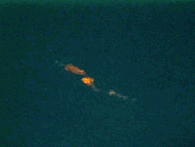
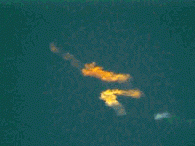
was captured by Ewald Lemke (Atlin Realty, Atlin, British Columbia). It shows the expanding smoke train of the Yukon meteor ... The first frame shows a smoky red vapor trail just 1 minute and 30 seconds after the initial flash. ... On Friday, January 21 -- just three days after the explosion -- an Airborne Sciences ER-2 aircraft from NASA's Dryden Flight Research Center flew to the Yukon Territory of northwestern Canada in an effort to collect atmospheric samples of the meteor's lingering debris trail. The region, near the town of Carcross, is mostly unpopulated. Scientists gathered samples of the debris cloud at an altitude of 65,000 feet with an instrument called the Aerosol Particulate Sampler (APS). The APS is a system of two small five-inch by four-inch paddles that deploy simultaneously from the ER-2's left wingtip. The paddles are coated with a silicon oil that collects particles from the high altitude air stream. After a period of exposure, the paddles are withdrawn into hermetic enclosures that prevent contamination during the aircraft's return to Dryden. The paddles will be removed and sent to NASA's Johnson Space Center in Houston, Texas for analysis. The ER-2 also carried a camera capable of taking black and white photos of eight-mile wide swaths of the region in an effort to locate any impact craters and other scarring of the earth, such as flattened areas of forest, that may have been caused by the explosion and impact of meteorites that separated from the meteor. ...". I wonder whether the meteorite could have been a fragment of Comet Hale-Bopp. According to a 16 March 2000 report in Space Science News: "... fragments of the meteorite have been recovered ... The finder, a local resident near the spot where the meteorite hit, collected the fragments from snow-covered ground. He placed them in clean plastic bags and kept them continuously frozen. ... The fragments -- lumps of crumbly rock with scorched, pitted surfaces -- resemble partly used charcoal briquettes: black, porous, fairly light and still smelling of sulfur. ...". A space.com article dated 16 March 2000, which has an image of a fragment,
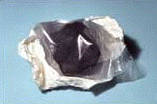
says: "... NASA in cooperation with Canadian authorities launched an ER 2 (U2) aircraft to capture dust samples from the upper atmosphere. ... The lab has about five pounds of samples ranging from charcoal briquette to fingernail size along with dust samples collected by the ER 2. ...". The Space Science News article goes on to say: "... Scientists say the meteorite was a carbonaceous chondrite, a rare type of space rock that contains many forms of carbon and organics, basic building blocks of life. Carbonaceous chondrites, which comprise only about 2 percent of meteorites known to have fallen to Earth, are typically difficult to recover because they easily break down during entry into Earth's atmosphere and during weathering on the ground.... About 2 pounds of fragments have been recovered so far. ... Scientific analysis of the fragments has just begun. Tests have been limited to two non-destructive activities: making a thin section to analyze the mineralogy of the fragments, and measuring induced radioactivity. Tests for induced radioactivity ... measure the object's exposure to space radiation. This can be used to determine the size of the original meteoroid in space, estimates of which range up to 50 feet in diameter, with a mass of more than 55 tons. The next step in the study of the fragments will be baseline analyses of the organics in the meteorite. This would require the destruction of some samples, and negotiations are under way with the finder for permission to do such tests. ...".
According to a 14 March 2001 Sky and Telescope web article: "... the Tagish Lake meteorite, which had dropped as a hail of fragments onto the Yukon's winter wilderness ... is still causing a scientific buzz because its unique composition, forged at the very beginning of the solar system, defies easy explanation. For example, some of its dark, crumbly interior is riddled with carbonate minerals created when liquid water percolated through the rock multiple times. Yet adjacent sections bear no carbonates or other traces of water's influence at all. And though chemists would have bet money that the black stones would have teemed with exotic hydrocarbon compounds, analyses turned up a disappointing yield &emdash; a thousandth the organic content of Murchison, a similarly carbon-rich meteorite that fell in 1969. "We were hoping to find all these amino acids," laments Iain Gilmour (Open University), "and they're just not there." What Gilmour and others have identified are puzzling clues to the meteorite's origin. Some of the organic components mimic the nitriles and other aromatic species known to exist in molecular clouds. So might Tagish Lake have an interstellar origin? Or, as Takahiro Hiroi (Brown University) speculates, are these pieces of one of the dark, carbon-rich "D-type" asteroids that lurk in Jupiter's vicinity? More than one specialist openly questioned whether this find could represent chunks of a comet's nucleus. ...".
THE FIRST PARALLAX CALCULATIONS of the distances of comets from the Earth were made around 1450, particularly of Halley's Comet in 1456, about the time China declined to become a global power. From then on, you could calculate the absolute magnitudes, and therefore estimated sizes, of comets. Here is a list of the top six, plus Hale-Bopp and the Sungrazer Parent:
Year Comet m0
10,000 BC Sungrazer Parent -5.0
1729 Sarabat -3.0
1577 Tycho -1.8
1997 Hale-Bopp -1.3
1747 De Cheseaux -0.5
1811 Flaugergues 0.0
1744 De Cheseaux +0.5
1882 Cruls +0.8
The Sungrazer Parent may have roughly coincided with the Vela Supernova and the end of the Ice Age.
Comet Sarabat was naked eye visible for 6 months at over 4 AU from the Sun.
As Sagan and Druyan noted in their book, Comet (Random House 1985, 1997), the radius of Comet Sarabat could have been around 100 km. If it had been made of liquid and had collided with Earth, its liquid would have covered the Earth to a depth of 10 meters.
The absolute magnitude of Hale-Bopp was about -1.3, after perihelion on 1 April 1997, according to Marc Kidger of IAC, making it probably the third largest comet since 1450, behind:
Comet Tycho of 1577, seen by Kepler as a child, about 11 years before the English defeated the Spanish Armada; andComet Sarabat of 1729 when Britain started the Industrial Revolution.
Lunar occulation for much of North America; unfortunately, apparently no useful science results.
This total eclipse begins at Gora Belukha and goes through Mongolia, China, and Siberia to the Arctic Ocean.
Here a painting of Hale-Bopp at totality by Shigemi Numazawa of Japan Planetarium Lab:
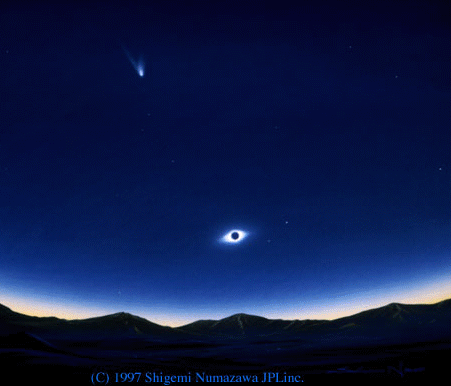
March 23, 1997 was the day after Comet Hale-Bopp was nearest Earth, about 1.3 AU away
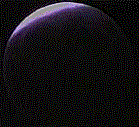
and also the day of this CNN lunar eclipse photo, and the day of a Falun Dafa lecture in New York City.
arrived at Earth around 10 April 1997, when the angular distance between the position of Hale-Bopp as seen from Earth was only about half a degree from the position of Hyakutake exactly one year earlier!
As noted by Richard West at ESO, Hyakutake was 81 million km from Earth on 10 April 1996, while Hale-Bopp was 217 million km from Earth on 10 April 1997.
Bill Hutchinson of Kenai, Alaska, photographed both comets on 11 April 1996 and 1997:
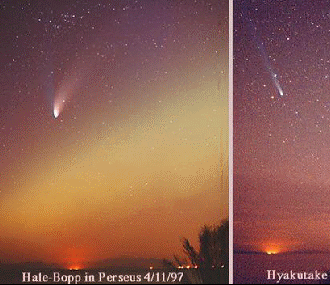
The aurora at Hale-Bopp is due to the CME of 7 April 1997, which occurred shortly after Hale-Bopp's perihelion on 1 April 1997.
Click HERE to see a 19 April 1997 photo by Hutchinson.
Richard West at ESO notes that on IAU Circular 6614 (April 7),BeppoSAX announced the detection of soft X-rays from the direction of Hale-Bopp between 1996 Sept. 10.16 and 11.18 UT.

Richard West at ESO (16 May 1997) noted that on 5 May 1997, Comet Hale-Bopp crossed the Earth's orbital plane at a distance of approximately 15 million km beyond the Earth's orbit, near where Earth will be in January 1998 .
Richard West at ESO also noted that John Lindquist says "... I think I may have seen something relevant late Friday, May 9. Just after sunset, while scanning the sky to the `lower right' of the crescent moon with binoculars, I saw a bright object for about a second or two - like a small luminous backslash (\). I didn't see any definite indication of the comet till dark, after a number of stars became visible. Then, while photographing it with my 70-210mm telephoto lens around 9PM (CDT), the tail appeared to flare up for about a second or two...."
Richard West at ESO also noted that Olivier Lardiere, J.C. Merlin, and S. Garro, have, on May 8, noticed some rapid changes in the inner coma. Now, the coma structure looks like the February structure. Dust shells become less visible, whereas new radial jets are emerging around the nucleus. Moreover, on May 8, 1997, a huge and bright concentration of dust was rapidly ejected from the nucleus toward the anti-solar direction. One day after the ejection, the dust spreads on over 50,000 km from the nucleus. The two following sequences from the 0.8-m telescope of the Observatoire de Haute-Provence show the evolution of the coma on three days. On the first sequence, we can see three original images obtained with an infrared filter on May 7, 8 and 9. The last sequence shows the corresponding rotational-shift-difference processed images. On May 8, 1997, a huge concentration of dust is ejected from the nucleus toward the anti-solar direction. The speed of ejection is very high. 24 hours after the ejection, the dust spreads on over 50,000 km from the nucleus. This dust ejection does not appear at each nucleus rotation, so it's certainly a unique phenomenon. Note the rapid expansion of the curved jet (in the direction of the sun). On May 9, this jet is twice longer than on May 7.
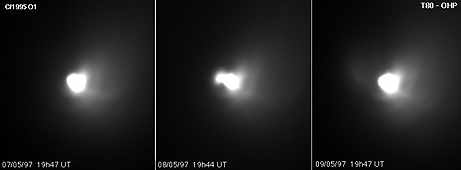

What appears to be the same phenomenon is also reported by Mark Kidger (IAC, La Laguna, Spain). He writes, among others, that Pablo Santos has just been showing me images from the Mons Telescope [at the Teide observatory on Tenerife] from May 8th and 9th. There appears to be a bright shell of material to the north of the comet seen in the exposures on May 8.91, probably expelled from the nucleus around May 8.8. This structure is seen as a faint and quite distant shell on May 9.91, but with the same distinctive concave shape....Nothing unusual is seen in the field on either the 7th or 10th.
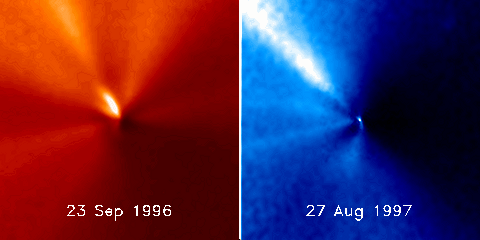
"The red image on the left is a pre-perihelion HST image of Hale-Bopp taken with the WFPC2 on 23 Sep 1996 when the heliocentric and geocentric distances were 2.97 AU and 2.95 AU, respectively, and the solar phase angle was 19 degrees. The blue image on the right is a post-perihelion HST image of Hale-Bopp taken with STIS on 27 Aug 1997 when the heliocentric and geocentric distances were 2.48 AU and 2.99 AU, respectively, and the solar phase angle was 18 degrees. For both images celestial North is straight up and East is to the left. Each image is 10.9 arcsec across, which projects to 23,800 km at the comet, and a single pixel subtends 99 km at the comet. The nucleus is at the center of each image. ... [W]e have divided the images ... by azimuthally-averaged images in order to enhance any asymmetrical structures in the coma. Strong jets are apparent in both images. Enhancements (depressions) along a jet indicate that the comet shows strong temporal variability. " HST STIS has a web page about Hale-Bopp observations by the Space Telescope Imaging Spectrograph of the Hubble Space Telescope.
5 January 1998: Hale-Bopp has a normal dust-tail in the anti-solar direction (to the North), extending over a distance of more than 4 degrees to the edge of the field. Since the photo was made near the time that the Earth was crossing the comet's orbital plane, they also show the so-called neck-line structure, a narrow and very straight feature in the same direction which is caused by sunlight reflected in the thin dust sheet in this plane. The true length of this feature depends on the exact geometry of the dust distribution, but may well be of the order of 1 AU (150 million km) or even more. Hale-Bopp has a narrow, sunward spike, or anti-tail, that may be followed at least 0.5 degrees in the other direction. The tail/anti-tail phenomenon is interpreted by ESO astronomer Hermann Boehnhardt as due to the presence of large and old dust grains that were released by the nucleus at least 100 days before these observations, possibly much earlier.
(5 January 1998 - ESO)
At the First International Conference on Hale-Bopp in Tenerife on 2-5 February 1998, Z. Sekanina of the Jet Propulsion Laboratory announced the detection of a
In the abstract of his Contributed Talk, abstract CT-2a-1, Sekanina says: "This paper reports the detection of a satellite around the primary nucleus of Comet Hale-Bopp. Overlapping jet activity from the comet pair could more easily explain the exceptionally complex morphology of the dust coma. The detection was made on images taken with the Hubble Space Telescope's Wide Field Planetary Camera 2 in the planetary mode on five days in May-October 1996. An average satellite-to-primary signal ratio is 0.21 +/- 0.03, suggesting that the satellite's diameter is about 30 km, if the main nucleus is about 70 km across. To avoid collision, the separation distance must exceed 50-60 km or more at all times. The satellite's projected distances derived from the images vary from 160 to 210 km, or 0.06 to 0.10 arcsec. The satellite was not detected in October 1995, presumably because of its subpixel separation from the primary. The radius of the gravitational sphere of action of the main nucleus of the assumed size is 370-540 km at perihelion, increasing linearly with the Sun's distance: the satellite appears to be in a stable orbit. Its orbital period at about 180 km is expected to be about 2-3 days, much shorter than the intervals between the HST observations. If the main nucleus should not be more than 42 km across, Weaver et al.'s upper limit, the satellite's orbit should become unstable and the object would drift away from the main nucleus after perihelion, contrary to observation. In fact, ground-based detections of massive multiple comets are altogether unlikely. Efforts to determine the satellite's orbit and the total mass of the system are expected to get underway shortly."
R. M. West of ESO gave an overview of the First International Conference on Hale-Bopp, saying in part: "... By very careful analysis of high-resolution HST images obtained in 1996, Zdenek Sekanina believes that the primary nucleus may have a lesser companion of approximately half the size. This issue is still somewhat controversial, but observations with the Adonis adaptive optics camera at the ESO 3.6 m telescope in November 1997 and January 1998 by three ESO astronomers also appear to show a double nucleus. More observations with this facility in the coming months and/or with the HST scheduled for later this month are expected to clarify this issue. ..."
H2O, HDO, OH, H2O+, H3O+, CO, CO2, CO+, HCO+,
H2S, SO, SO2, H2CS, OCS, CS, CH3OH, H2CO, HCOOH,
CH3OCHO, HCN, DCN, CH3CN, HNC, HC3N, HNCO, CN, NH3,
NH2, NH2CHO, NH, CH4, C2H2, C2H6, C3, C2, He, Na, K, O+
H13CN, HC15N, C34S
Richard West at ESO also mentions that "On IAU Circular 6645 (May 7, 1997), R. W. Russell and collaborators at The Aerospace Corporation, report a clear detection of features at 11.8 and 11.25 microns in the high signal-to-noise BASS spectra of comet C/1995 O1 in 1996 October and November, similar to features seen in the spectra of comet 1P/Halley. Spectral-synthesis modeling results in the identification of both features with emission by crystalline olivine grains [eds. bold], adding strength to their earlier detection.... In contrast to the earlier work, this model uses laboratory emissivity data on celestial dust-analogue samples as inputs. The presence of all of the expected structure in the region 8-13 microns strengthens the identification with a crystalline component of olivine-like composition in this comet."
Hale-Bopp, unlike Comet Hyakutake, was formed in the Solar System, according to a Sky and Telescope (Feb 98) Newsnotes report that, according to ultraviolet and millimeter-wave observations, Hale-Bopp has isotope ratios consistent with a Solar System origin.
On 13 March 1998 (Science, Volume 279, Number 5357, pp. 1707 - 1710) Meier, Owen, Jewitt, Matthews, Senay, Biver,Bockelée-Morvan, Crovisier,and Gautier report that deuterated water (HDO) in Comet Hale-Bopp appears to be essentially the same in Comets Halley, Hyakutake, and Hale-Bopp: D/H = (3.16 ± 0.34) x 10^(-4 ). If comets have preserved unmodified interstellar material, we expect hydrogen-containing compounds other than H2O to exhibit different values of D/H, a well-known result of ion-molecule reactions in interstellar clouds. Deuterated hydrogen cyanide (DCN) was detected in Hale-Bopp with the Maxwell Telescope on Mauna Kea, Hawaii. The inferred deuterium/hydrogen (D/H) ratio in hydrogen cyanide (HCN) is (D/H)HCN = (2.3 ± 0.4) x 10^(-3). This ratio is higher than the D/H ratio found in cometary water and supports the interstellar origin of cometary ices. The observed values of D/H in water and HCN imply a kinetic temperature greater than or equal to 30 ± 10 K in the fragment of interstellar cloud that formed the solar system.
Blake, Qi, Hogerheijde, Gurwell, and Muhleman, in a paper published in Nature 398 (18 Mar 99) 213-215,state that "... 1''--3'' millimetre-wave aperture synthesis observations of HNC, DCN, and HDO in comet Hale-Bopp reveal arc-like structures offset from the nucleus. The measured (HNC/HCN), (DCN/HCN), and (HDO/H2O) abundance ratios are substantially higher than those on larger scales or than can be accounted for by coma or equilibrium nebular chemistry models, but are similar to the values observed in dense interstellar cloud cores and young stellar objects. We propose that sublimation from millimetre-sized icy grains lifted by jets provides access to volatiles that would otherwise be altered by diffusion through warm surface layers of the nucleus. The (D/H) ratios further suggest that by mass Hale-Bopp, and by inference the outer solar nebula in general, consists of >15-40% largely unprocessed interstellar material. ...". Sky and Telescope has a news article about their paper, stating: "... Geoff Blake and his colleagues explain that the water in Hale-Bopp -- as detected using the Owens Valley Radio Observatory Millimeter Array -- has much more heavy water than the Earth currently does. This implies that the water in our rivers, lakes, and oceans did not originate from cometary impacts. ...". My opinion is that the results only show that ALL of the water on Earth did not originate from comets of the type of Hale-Bopp. In Proc. Natl. Acad. Sci. USA, Vol. 98, Issue 3, 809-814, January 30, 2001, Jonathan Lunine says: "... Although most of Earth's water may have come from asteroids, it is possible in principle that most of the organic molecules came instead from comets. ...".
According to Dr. Michael DiSanti of Catholic University and NASA's Goddard Space Flight Center (Greenbelt, Md.), commenting on research published Nature 399 (17 June 1999) 662-665: "Our observations of Hale-Bopp indicate that comets now in the distant Oort cloud were originally part of the solar system's ancient proto-planetary disk. It was thought that comets could have formed in the cold, dense cloud of gas and dust that existed before the proto-planetary disk formed. However, if this were so, we would have seen even more carbon monoxide emission from Hale-Bopp. The amount of carbon monoxide ice compared to water (12 percent) indicates that these comets formed somewhere between the orbits of Jupiter and Neptune. We hope to learn more about what was going on when the giant planets formed by investigating the chemistry of this comet."
With regard to the same research (Nature 399 (17 June 1999) 662-665), Dr. Michael Mumma of Goddard said: "There is another group of comets that may be more like the cold, dense cloud that preceded the solar system disk. Kuiper belt objects lie beyond the orbit of Pluto, and probably formed from remnants at the fringes of the proto-planetary disk. They are believed to be the source of comets with short orbital periods and low inclinations to the ecliptic plane. This region is remote from the Sun, and that part of the disk would have been less influenced by radiation from the young Sun, so ices in Kuiper belt objects are probably more like those in the original cloud from which the solar system formed ... Future measurements may reveal this difference."
According to an article 5 June 2000 on the space.com website, by Greg Clark, "... Comet Hale-Bopp, which paraded across evening skies during the winter and early spring of 1997, may have formed in our solar system somewhere near Neptune, ... said Alan Stern ... [who] directs the Southwest Research Institute's Space Studies Department, and is principal investigator of the team that analyzed Hale-Bopp. ... the discovery of a certain noble gas tells scientists that an object has spent most itís life without heating above the temperature where that gas would steam off into space. In space, argon is solid only below about 35 degrees Kelvin (minus 395 degrees Fahrenheit, or minus 238 degrees Celsius). The presence of abundant argon means that the comet has formed in a region of space that is no hotter than 35 degrees Kelvin, Stern said. Some scientists have guessed that Hale-Bopp originated near Jupiter, but the argon finding rules out this possibility because that region is likely too warm for argon. ... a NASA satellite which searched for neon - a noble gas that has a melting point below that of argon .. detected no neon in Hale-Bopp, a fact that means the comet formed above about 20 degrees Kelvin (minus 424 degrees Fahrenheit or minus 253 degrees Celsius), Stern said. This profile, where the general temperature is above 20 degrees but below 35 degrees Kelvin, matches the temperature of the Neptune region, an area some 30 times farther from the sun than Earth. ... In fact it indicates that it was probably born somewhere in the Uranus-Neptune [region] or, possibly, even further out. ...".
Hale-Bopp is still visible in 2001 - a New Century and New Millenium.
According to a 6 March 2001 ESO web page: "... Comet Hale-Bopp, still active at a distance of nearly 2,000 million kilometres from the Sun.
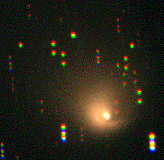
The photo is a colour composite of several exposures in different wavebands, obtained with the Wide-Field Imager (WFI) camera at the MPG/ESO 2.2-m telescope at the La Silla Observatory. Despite the very large distance from the Sun, the comet is still "active" - it continues to lose material, as demonstrated by the curved jet, and also possesses an enormous coma. The broad, fan-shaped extension in the tail direction
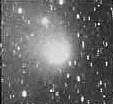
(to the upper left) measures at least 2 million kilometres ... the comet has been moving away from the Sun and is now located at a distance that corresponds to nearly midway between the orbits of Saturn and Uranus. However, as the comet's orbit is highly inclined to the main plane in which the major planets move, Hale-Bopp is now far below that plane. It is seen deep in the southern sky, south of the Large Magellanic Cloud in the constellation Dorado (The Goldfish). ... The large 'dirty snowball' nucleus of ice and dust (probably about 50 km diameter) continues to be active, despite the very low temperature where it is now. This is quite unusual for a comet and is clearly confirmed on the present photo ... obtained a few days ago. The comet was about 1950 million kilometres (13.0 AU) from the Sun (and about 1965 milion km from the Earth). ... Hale-Bopp still has the prominent, curved jet-like structure in the coma that has been observed earlier. No changes in this structure were observed during the three nights of observation. ... The total size of the comet is still a staggering 2 million kilometres, or about five times the distance between the Earth and the Moon. ... Astronomers at ESO and elsewhere will continue to follow Hale-Bopp as long as possible, perhaps during the next several decades. It is still relatively bright (magnitude 14.5, or about 2500 times fainter than what can be seen with the unaided eye in a dark sky). It is now moving outwards at a speed of about 11 km/sec, or 1 million km per day. It will be interesting to see how long the present, highly unusual activity continues. ...".
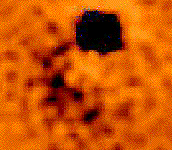
(28 Aug 95 - IAC80, M. R. Kidger) (26 Sep 95 - HST, Weaver & Feldman)
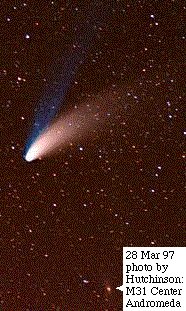
(28 Mar 97 - HB Magazine) (24Mar97-4x4arcmin-I-band-USNO)
(Blue minus Red Ion Tail image - 15 Apr 97 - Pic du Midi)
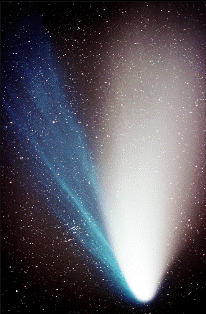
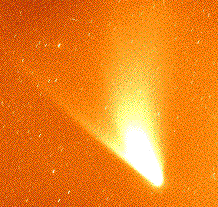
(6 Apr 97 - Mikuz and Kambic, Crni Vrh) (Sodium Tail - 16 Apr 97 - ING)(7 April 97 - Purgathofer-Observatory - 3 filter methods)
According to a JPL web page: "... short-periodic ... Comet Shoemaker-Levy 9 ... was first detected on a photograph taken on the night of March 24, 1993 with the 0.4-meter Schmidt telescope on Palomar Mountain in California. Subsequent observations ... were used to demonstrate that the comet was in orbit about Jupiter, and had made a very close approach (within 1.4 Jupiter radii from Jupiter's center) on July 7, 1992. During this close approach, the unequal Jupiter gravitational attractions on the comet's near and far sides broke apart the fragile object.
According to a JPL web page: "... A time sequence of four frames showing the impact of the first of the 20 odd fragments of Comet Shoemaker-Levy 9 into Jupiter.
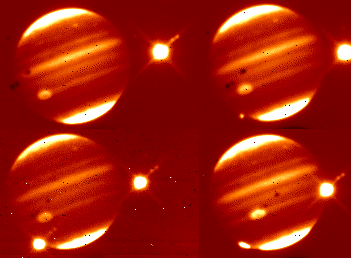
The upper left frame shows Jupiter just before impact. The bright object to the right is the closest Galilean satellite Io, and the fainter oval structure in the southern hemisphere is the Great Red Spot. The polar caps appear bright at the wavelength of the observations, 2.3 um, which was selected to maximize contrast between the fireball and the jovian atmosphere. In the second frame, taken from Spain at about 10:15pm on July 16, the fireball appears above the southeast (lower left) limb of the planet. The fireball flared to maximum brightness within a few minutes, at which time its flux surpassed that of Io. The final frame shows Jupiter approximately 20 minutes later when the impact zone had faded somewhat. Further monitoring suggests that the bright zone is rotating slower than the cloud deck on Jupiter, implying that the fireball is high in jovian atmosphere. At the time of this writing nearly three hours after the event, remnant flux is still visible. These images were taken at the German-Spanish 3.5 meter telescope on Calar Alto in southern Spain, using the near infrared camera of the Max-Planck-Institut fuer Astronomie in Heidelberg, Germany. ...".
According to a JPL web page: "... This is a composite photo, assembled from separate images of Jupiter and comet P/Shoemaker-Levy 9, as imaged by the Wide Field & Planetary Camera-2 (WFPC-2), aboard NASA's Hubble Space Telescope (HST). Jupiter was imaged on May 18, 1994, when the giant planet was at a distance of 420 million miles (670 million km) from Earth. This "true-color" picture was assembled from separate HST exposures in red, blue, and green light. Jupiter's rotation between exposures creates the blue and red fringe on either side of the disk. HST can resolve details in Jupiter's magnificent cloud belts and zones as small as 200 miles (320 km) across (wide field mode). This detailed view is only surpassed by images from spacecraft that have traveled to Jupiter. The dark spot on the disk of Jupiter is the shadow of the inner moon Io. This volcanic moon appears as an orange and yellow disk just to the upper right of the shadow. Though Io is approximately the size of Earth's Moon (but 2,000 times farther away), HST can resolve surface details.
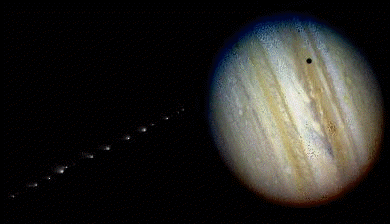
When the comet was observed on May 17, its train of 21 icy fragments stretched across 710 thousand miles (1.1 million km) of space, or 3 times the distance between Earth and the Moon. This required six WFPC exposures along the comet train to include all the nuclei. The image was taken in red light. The apparent angular size of Jupiter relative to the comet, and its angular separation from the comet when the images were taken, have been modified for illustration purposes. ...".
Louis Frank contends that
the size of a small house hit the Earth's atmosphere about every three seconds. They would be water snowballs weighing about 30 tons, vaporizing at altitudes from about 25,000 km to 1,000 km. They would deposit about an inch of water every 10,000 years, plus (possibly) some organic compounds. They would not contain the metal and dust of ordinary comets.
Frank bases his contention that such Small Comets exist on dark spots seen in satellite images of the upper atmosphere. Some other astronomers disagree with Frank, and contend that the dark spots are due to noise generated inside the cameras taking the images. The issue of whether or not the Small Comets really exist had not been conclusively resolved as of June 1998 (See Science 280 (12 Jun3 1998) 1695-1696.)
......